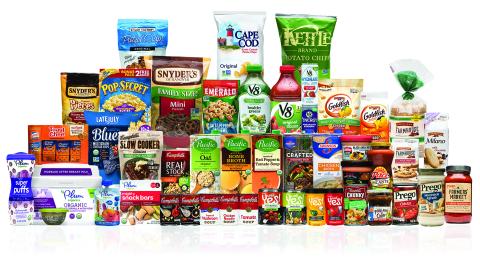How Campbell Got Its Groove Back
There aren’t many companies or brands more iconic than Campbell Soup Co. The 150-year-old company’s flagship brand, along with others such as Prego, Pace, Swanson, V8, Pepperidge Farm, Kettle Brand, Snyder’s and Lance, can be found in virtually every U.S. household. However, a deep penetration rate and iconic status alone don’t equate to growth in today’s CPG world.

It’s a challenge that Camden, N.J.-based Campbell — and really all old-guard CPG companies — has wrestled with for years. To address the situation, Campbell began a major transformation in mid-2018 that included the appointment of CPG veteran Mark Clouse as CEO roughly one year ago. Since the former Pinnacle Foods CEO and veteran of Mondelez and Kraft joined Campbell, there has been a flurry of activity, all of it rooted in refocusing the company on core businesses, restoring retailer relationships, driving sales and executing a multifaceted innovation agenda.
“I see a pretty balanced view of both challenges and opportunities, but the one thing that I think we can all agree on is that there’s really never been a period of transformation like we’ve seen over the last five years,” Clouse told Progressive Grocer. “It really revolves around change and transformation in the consumers that we’re serving, our customers that we’re partnering with and the competition that we’re facing.”
Laying the Groundwork for Growth
To address all of those dynamics, Campbell has undergone a period of considerable disruption and repositioning. The process began in March 2018, when Campbell did the largest deal in its history, acquiring Snyder’s-Lance and instantly becoming a major player in the snacking world. Two months later, CEO Denise Morrison departed after a seven-year run, and board member Keith McLoughlin stepped in to fill the top job on an interim basis.

He led a portfolio review that resulted in a decision to divest major parts of the business.
Clouse joined Campbell in January 2019 and has overseen the company’s sale of its international and fresh divisions, which raised $3 billion. Today, Campbell is a leaner organization with a simplified focus on two core North American segments: snacks and meals & beverages.
It’s been a turbulent 18 months for Campbell, which is why Clouse characterized 2020 as a year of stabilization and laying the groundwork for growth with its roster of well-recognized brands and fresh thinking from leadership. To drive growth, Campbell has dedicated itself to reinvigorating innovation with the products it brings to market, how they are presented and the type of conversations it has with retailers.
"How are we going to grow the store traffic and the share of market with our customers? That’s what they want to talk about. And to do that, how do we work more efficiently so more of our dollars can be working to drive demand?”
Promoting Plant-Based
The shift is evident in new marketing campaigns connecting with Millennials and the clean-label trend. However, some re-education is required because consumers may perceive product quality as low or unhealthy. Ironically, a product like V8 is arguably the original plant-based beverage, and soups such as classic tomato, with six tomatoes in each can, or even chicken noodle possess relatively few ingredients. Campbell is addressing these quality and healthfulness perceptions with new advertising, which Clouse maintained has shown promising early results.
Campbell is also benefiting from being a major player in certain categories that align with trends, like the phenomenon of quick-scratch cooking and strong sales of home-cooking appliances that facilitate the trend.
“For years, we talked about people’s departure from cooking, but what’s happening is consumers are actually coming back to what we call quick-scratch cooking, which is simple combinations of ingredients to create a meal,” Clouse said.
Other forms of innovation relate to applying new trends to existing brands. For example, Campbell is introducing a plant-based Bolognese sauce and is exploring soups with plant-based chicken ingredients to capitalize on a trend that Clouse sees as among the biggest in food.
Reshaping the Aisle
Snacking is also an area ripe for innovation, but in less obvious ways, with new usage occasions for products like nutrient-dense sippable bone broths. These protein-laden products can serve as lower-calorie alternatives to protein bars, or even replace an afternoon trip to Starbucks, if enhanced with green tea extract for a caffeine boost.

Innovation will also be showing up in the soup aisle, where a new approach to presentation is designed to reflect how buyers shop the category. Campbell is rolling out a new approach with cooking soups like broths and condensed products flowing to ready-to-eat brands, and then convenience and snackable products. It’s about reshaping the aisle to match consumer behavior.
“That’s how we believe we’ll create greater levels of engagement within the aisle,” Clouse said.
There’s a lot going on at Campbell as the company enters year two of a three-year plan led by Clouse, a West Point graduate and former U.S. Army captain whose specialty in the service was flying Soviet-era helicopters in training exercises. That’s not exactly a skill that translates to civilian life, but his military service nonetheless instilled in him the type of discipline and leadership essential for major CPG companies faced with an array of nontraditional challenges.
“The great differentiator — it doesn’t really matter what field you’re in — is leadership,” Clouse observed. “I’ve always been grateful for the opportunity, at a relatively early age, [of] being thrown into the deep end of the pool, as it were, and leading 20 to 30 people on pretty complicated missions, with very high stakes, as a way to learn. The military does, in a very unique way, give you those experiences, perhaps ahead of a lot of other occupations, and it really did prepare me well for the leadership challenge of being in a commercial environment.”








